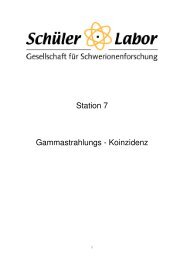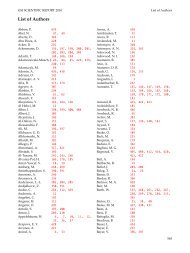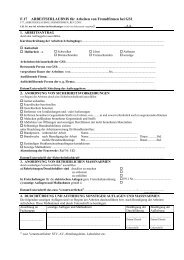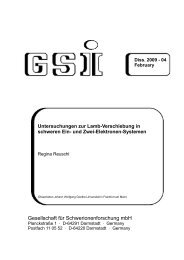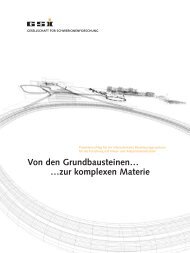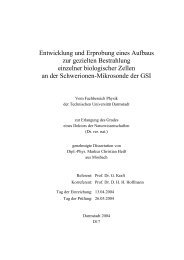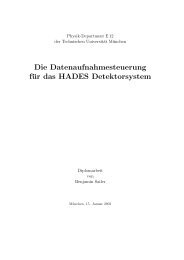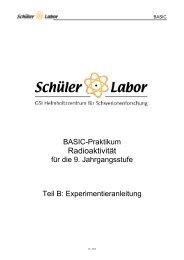CBM Progress Report 2006 - GSI
CBM Progress Report 2006 - GSI
CBM Progress Report 2006 - GSI
You also want an ePaper? Increase the reach of your titles
YUMPU automatically turns print PDFs into web optimized ePapers that Google loves.
<strong>CBM</strong> <strong>Progress</strong> <strong>Report</strong> <strong>2006</strong> Simulations<br />
The goal of the <strong>CBM</strong> experiment is the investigation of<br />
the properties of compressed nuclear matter as produced in<br />
high-energy heavy-ion collisions. The main interest is the<br />
search for in-medium modifications of hadron properties<br />
and for the phase transition boundary between hadronic and<br />
quark-gluon matter at highest baryon densities.<br />
In heavy-ion collisions at relativistic energies, a large<br />
number of particles is produced. In central Au+Au collisions<br />
at 25 GeV/n, about 800 tracks are within the acceptance<br />
of the Silicon Tracking System (STS) of <strong>CBM</strong>.<br />
The reconstruction of such events, strongly kinematically<br />
focussed due to the fixed-target setup, is very challenging.<br />
Several track finding algorithms are currently being developed<br />
to cope with the extreme environment.<br />
In the Laboratory of High Energy (LHE) at JINR Dubna,<br />
a track finding algorithm based on the approximate solution<br />
of motion equation (ASME) for particles [1] has been developed<br />
with special focusing on the finding of secondary<br />
particles. This algorithm was tested for events of central<br />
Au+Au collisions at 25 GeV/n. The STS setup used consisted<br />
of two MAPS stations (d = 150 µm) at z = 10 cm and<br />
20 cm, two hybrid pixel stations (d = 750 µm) at z = 30 cm<br />
and 40 cm, and four micro-strip stations (d = 400 µm, z =<br />
50, 60, 75 and 100 cm). The single-hit efficieny was 99 %<br />
in the first two stations and 100 % in the others. The fake<br />
hit rate in the MAPS stations was 3 %, while the projective<br />
geometry led to a large number (80 %) of fake hits in the<br />
strip stations. Due to these reasons we have restricted ourselves<br />
to finding tracks with at least four consecutive hits<br />
in stations 2 - 6. With this constraint, the algorithm reconstructs<br />
∼ 600 tracks per event for physics analyses.<br />
efficiency<br />
1<br />
0.8<br />
0.6<br />
0.4<br />
0.2<br />
0<br />
0 1 2 3 4 5<br />
P (GeV/c)<br />
Track reconstruction in the <strong>CBM</strong>-STS<br />
O. Rogachevsky and A. Jerusalimov<br />
all<br />
primary<br />
secondary<br />
Figure 1: Track reconstruction efficiency as a function of<br />
momentum for all, primary and secondary particles<br />
JINR, Dubna, Russia<br />
5<br />
Figure 1 shows the track finding efficiency as a function<br />
of momentum. We obtain a good efficiency for primary<br />
particles with momenta above 0.5 GeV/c and a reasonable<br />
efficiency for secondary particles, allowing studies of longlived<br />
decaying particles.<br />
The relative momentum resolution obtained from the<br />
track fit is shown in Figure 2 as function of momentum.<br />
Its value is about 1.6 % roughly independent on momentum,<br />
thus demonstrating that it is dominated by multiple<br />
scattering in the STS detector material. A good resolution<br />
for the masses of decayed particle is achieved as well.<br />
P / P (%)<br />
Δ<br />
5<br />
4<br />
3<br />
2<br />
1<br />
0<br />
0 0.5 1 1.5 2 2.5 3 3.5 4 4.5 5<br />
P (GeV/c)<br />
Figure 2: Relative momentum resolution for all reconstructed<br />
tracks as function of momentum<br />
The algorithm is very fast (5 − 8 s per event) and the<br />
results obtained with it are promising. Further development<br />
of this algorithm is in progress.<br />
References<br />
[1] A. Jerusalimov: Reconstruction of track parameters in nonuniform<br />
magnetic field, http://www.gsi.de/Documents/DOC-<br />
2005-Jan-58.html



